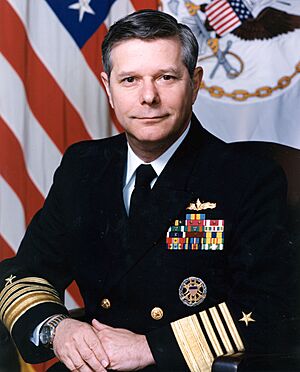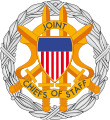Michael Boorda facts for kids
Quick facts for kids
Michael Boorda
|
|
|---|---|

Boorda's official Chief of Naval Operations portrait; note the two ribbons with "V" devices
|
|
| Nickname(s) | Mike |
| Born | November 26, 1939 South Bend, Indiana, United States |
| Died | May 16, 1996 (aged 56) Washington, D.C., United States |
| Buried |
Arlington National Cemetery (Section 64, Lot 7101 Grid MM-17)
|
| Allegiance | United States |
| Service/ |
United States Navy |
| Years of service | 1956–1996 |
| Rank | Admiral |
| Commands held | Chief of Naval Operations United States Naval Forces Europe Allied Forces Southern Europe Chief of Naval Personnel Cruiser-Destroyer Group Eight Destroyer Squadron 22 USS Farragut USS Parrot |
| Battles/wars | Vietnam War Bosnian War |
| Awards | Defense Distinguished Service Medal (2) Navy Distinguished Service Medal (4) Army Distinguished Service Medal Air Force Distinguished Service Medal Coast Guard Distinguished Service Medal Legion of Merit (3) Meritorious Service Medal (2) Navy and Marine Corps Commendation Medal Navy and Marine Corps Achievement Medal |
Jeremy Michael Boorda (November 26, 1939 – May 16, 1996) was a high-ranking officer, an admiral, in the United States Navy. He became the 25th Chief of Naval Operations (CNO). This was a very important job, as the CNO is the highest-ranking officer in the U.S. Navy. Admiral Boorda was special because he was the first person to start his Navy career as an enlisted sailor and then rise all the way to become the Chief of Naval Operations.
Contents
Early Life and Family
Jeremy Boorda was born in South Bend, Indiana, in 1939. His family later moved to Momence, Illinois.
When he was 19, Boorda married Bettie Mae Moran. They had three sons, David, Edward, and Robert, and a daughter named Anna. Their first son, David, was born with serious disabilities. Boorda and his wife raised their children as Protestants.
Boorda joined the United States Navy in 1956 when he was 17 years old. He left high school to enlist. He later finished his high school education while serving in the Navy. He worked his way up to become a Personnelman First Class.
Becoming an Officer
In 1962, Boorda was chosen for a special program called the Integration Program. This program allowed enlisted sailors who showed great potential to become officers. Boorda attended the Navy's Officer Candidate School in Newport, Rhode Island. He graduated in August 1962 and became an ensign, which is a junior officer rank.
His first officer job was on the ship USS Porterfield. Later, in 1964, he went to the Naval Destroyer School.
Service in Vietnam
In October 1964, Boorda served as a weapons officer on the destroyer USS John R. Craig. This ship went to Vietnam in March 1965 and took part in combat missions. For his good work during this time, he received the Secretary of the Navy Commendation for Achievement.
After this, he commanded another ship, USS Parrot. He also taught as a weapons instructor. In 1971, he earned a college degree in political science from the University of Rhode Island. He then became the Executive Officer of USS Brooke, a guided missile destroyer. His second tour in Vietnam was from November 1972 to February 1973. He received the Navy Commendation Medal for his service on the Brooke.
Rising Through the Ranks
Boorda continued to take on more important roles. He commanded the ship USS Farragut from 1975 to 1977. He also worked as an assistant to the Assistant Secretary of the Navy (Manpower and Reserve Affairs) in Washington, D.C.
In 1981, he took command of Destroyer Squadron 22. He later became an executive assistant to the Chief of Naval Operations. In 1986, he became commander of Cruiser-Destroyer Group Eight in Norfolk, Virginia. He also commanded the Battle Force Sixth Fleet in 1987.
In August 1988, Boorda became the Chief of Naval Personnel. This meant he was in charge of all Navy personnel. In November 1991, he earned his fourth star, becoming a full admiral. In December 1991, he became Commander in Chief of Allied Forces Southern Europe (CINCSOUTH) and Commander in Chief of United States Naval Forces Europe (CINCUSNAVEUR). As CINCSOUTH, he led all NATO forces involved in operations during the Yugoslav wars.
On February 1, 1993, Admiral Boorda also took on the role of Commander, Joint Task Force Provide Promise. This task force was responsible for delivering aid to Bosnia-Herzegovina during the conflict there.
On April 23, 1994, Jeremy Boorda became the 25th Chief of Naval Operations. He was the first CNO who had not graduated from the United States Naval Academy. He was also the first CNO of Jewish descent.
Key Initiatives as CNO
As Chief of Naval Operations, Admiral Boorda started several important programs and changes.
Seaman to Admiral Program
Admiral Boorda himself had started his career as an enlisted sailor. He strongly believed that people should have the chance to succeed, even if they didn't have a traditional start. Because of this, he brought back a program called "Seaman to Admiral." This program helps young sailors earn their commission and become Navy officers. It's now part of the STA-21 initiative.
Boorda was very interested in improving the Navy's technology, especially in areas like command, control, communications, computers, and intelligence (C4I). He wanted naval ships to have better combat information systems and improved satellite links.
He pushed for new ships, like the future LPD-17 amphibious class, to be built with top-notch C4I systems, radars, and defense systems. This was a new approach, as these functions were usually handled by separate destroyers or cruisers.
Changes to Personnel Systems
Admiral Boorda also led efforts to change how the Navy evaluated its officers and enlisted sailors. The new systems were more organized and fair. They made it clearer how an officer or sailor could advance in their career. For example, only a certain percentage of officers or sailors could be marked as "early promotes."
Focus on Coastal Oceanography
Boorda signed a new policy for naval oceanography, which is the study of the ocean. This policy emphasized that Navy oceanographers needed to understand not only deep-water areas but also the complex littorals, which are the near-shore areas. This new focus helped align the Navy's study of the ocean with its policies for operations near coastlines.
Death

Admiral Jeremy M. Boorda passed away on May 16, 1996, at his home in the Washington Navy Yard. He is buried at Arlington National Cemetery.
Awards and Decorations
Admiral Boorda received many military awards and decorations during his career. Some of these include:
- Defense Distinguished Service Medal
- Navy Distinguished Service Medal
- Army Distinguished Service Medal
- Air Force Distinguished Service Medal
- Coast Guard Distinguished Service Medal
- Legion of Merit
- Meritorious Service Medal
- Navy and Marine Corps Commendation Medal
- Navy and Marine Corps Achievement Medal
- Vietnam Service Medal
Legacy
Admiral Boorda's family has a strong tradition of military service. Two of his sons and one daughter-in-law are naval officers. He also has four grandsons who have served in the U.S. military:
- Peter Boorda served in the United States Coast Guard.
- Andrew Boorda is an armor officer in the U.S. Army.
- Phillip Boorda is an amphibious assault vehicle officer in the U.S. Marine Corps.
- Robert Dowling is an intelligence officer in the U.S. Army.
Andrew and Phillip are twins, and like their grandfather, they both graduated from the University of Rhode Island.
Admiral Jeremy M. Boorda Award
The Navy created an annual award in Admiral Boorda's honor, first given out in 2003. This award recognizes a Navy military member and a civilian who have made important contributions to Navy personnel readiness. This means they have helped make sure Navy personnel are well-prepared and supported.
Images for kids


